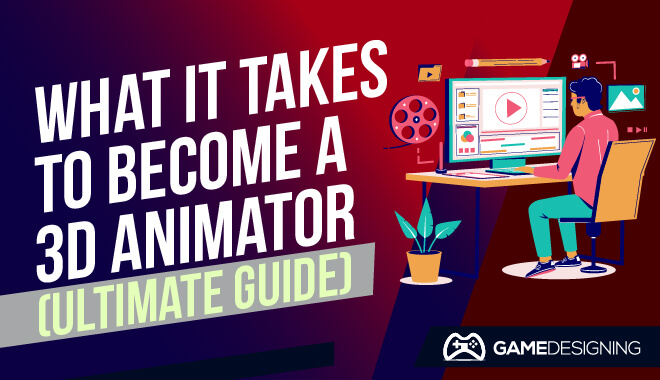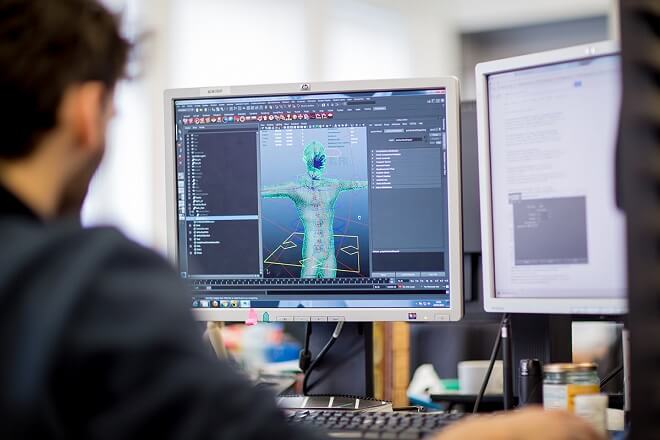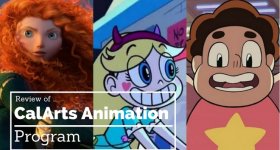
The Job of a 3D Animator
The job of a 3D animator and designer isn’t all glamour and creating Pixar movies. Well, some of it definitely is, but not without hard work. Let’s take a deep dive into 3D animator as a career choice, what you need to succeed, and how to land a job.
Should I Become a 3D Animator?
Yes! Well, if that’s what you are interested in. It is one of the more creative fields to join these days and can be extremely rewarding.
Is 3D animation a promising career? Yes, it can be gratifying and lucrative. However, there are a few aspects of becoming one of these talented designers.
You won’t be earning six figures right out of art school. However, if you put in enough hard work and use the right software, your work will definitely turn heads.
It can be fun and challenging, and ultimately, rewarding.
The Characteristics of a 3D Animator
The characteristics of an animator, while not universal, follow the same trends. For example, an animator can’t get by being lazy. Or a lousy team player.
What skills do you need to be a 3D animator? Patience, dedication, teamwork, and more. Collaborating within a group is crucial to success, as even big-time animation studios like Pixar have large groups working on important deadlines. We’ll explore this dynamic a bit more later on.
The Technical Skills of a 3D Animator
Okay, now that we know the characteristics of a 3D animator and designer, what technical skills do you need to be a 3d animator? Programming, model rendering, drawing, technology, and VFX. Of course, there are more skills depending on what programs you use and what you specifically animate.
Degree Level
The standard degree that animators need is usually a bachelor’s degree. Many have scored full-time, lucrative animating gigs with a traditional four-year degree. Here’s a list of what we believe to be the 71 best animation schools around the world and online.
Degree Field
Okay, so a four-year degree can usually swing it. But what do you major in? Usually, art students will major in specific fields like animation and design. Some schools have even more particular specializations to choose from to narrow it down and give you more specialized knowledge and skills.
Experience
Arguably one of the essential things an animator or designer needs and art school credentials is raw experience. This can be through various internships, work programs, or university initiatives that pair you with a mentor. You can also take any number of online art courses.
A significant part of these online courses is that many classes are small and intimate, often having under ten people attending. This gives you an excellent opportunity to form a bond with a professor, instructor, or mentor.
Or you can seek out an internship, the old tried and true method of gaining meaningful work experience. Either way, showing a hiring manager that you have raw expertise gives you an edge in an interview.
Getting There

Know Your Path
So how are you going to go about getting to your destination? Have any idea? There are multiple ways to do it, so don’t be afraid to experiment. Also, you need to know about what to animate.
Know Where to Start
One of the most difficult challenges of starting a career as a designer is finding a good place to start. Whether it’s a lack of motivation or finding a career path too daunting, you can easily get held up.
Know Where to Learn
A great way to break through the paralysis is by research. Research what university, community college, or art school you would like to attend. Do they offer a major in your particular area of interest? Can you get a scholarship? Get online and do some detailed searches.
Learn Body Mechanics
Learning how a body move is how you master animation. Without this crucial knowledge, you have no hope. Study animation techniques, ways in which physics influence movement, and more.
Learn Good Communication Skills
Communicating, while a useful skill in life, is doubly helpful as an animator. You will likely work as part of a team working on strict deadlines. That means you need to be able to communicate thoughts and ideas effectively. If you can’t communicate with your team, your projects will be dead on arrival.
Practice
Once you land a job as an animator, you never stop improving. It’s not time to get complacent. Practicing your craft every day, no matter what it is, is a fantastic strategy to get better at it. Getting better at it opens up better opportunities. Pretty simple, right?
Push Yourself
Don’t be afraid to animate outside your comfort zone. It may feel safe to strictly animate what you know, but by challenging yourself and your expectations, you can end up surprising yourself and others.
Level Your Expectations and Exceed Everyone Else’s
Having high expectations of yourself is okay. However, if you fail to meet sky-high expectations, it could hurt your work. What are other people expecting of you? Focus on those expectations.
Steps to Become A 3D Animator
Build a Portfolio
It can’t be overstated. Building a cohesive and impressive portfolio is a direct way to get hired more easily. Working on your own projects, along with the prior experience of an internship or past position, can really make you stand out to recruiters.
Get Experience
You can’t succeed as an animator if you don’t have experience. Even if you miraculously landed a job right out of high school, you absolutely need that dynamic of earning experience to better prepare yourself for the future. Whether it’s learning teamwork strategies or knowing how to accept constructive criticism, those things can’t be learned in a classroom.
Continue Your Education
Your education doesn’t stop once you receive your diploma. Every day, you will learn something new. Whether it is from talented coworkers or your mistakes, education doesn’t stop merely because you stop taking classes.
Education & Training Requirements
Prospective 3D animators need to keep a few things in mind. You likely won’t be accepted into the art community without some serious credentials. I’m talking about art school, internships, and college courses.
Let’s go over the different challenges and hurdles you need to overcome to become a full-fledged 3D animator and designer.
Education
Possibly one of the most critical pieces of your future portfolio is where you got your art knowledge. During job interviews, hiring managers want to see that you put your time into developing your skills through art courses and more.
Now, these don’t need to be Ivy League schools by any measure. Many successful animators and designers land jobs with associate degrees from a community college or a high school diploma with relevant work experience.
This latter option is relatively rare. Either way, art school is a great way to test your skills for a future career.
Art Skills

Life drawings
Since 3D animators spend their entire time animating, they only make sense that they would need to know how things move.
To get a better idea of how figures and other objects move, would-be animators partake in life drawings. This is how artists and designers get a better feel for how a body moves. This is important if they aim to make a realistic animation between multiple characters.
Where Do 3D Animators Work?
3D animators can work in numerous places. You can usually find teams of 3D animators and designers at game companies, movie studios, or even their home office. It depends on what their workloads look like, their job titles, and what company they work for.
For designers and animators, there is no definitive work situation that applies to the job.
3D Animator Salary & Job Outlook
Now that you know more about a team of 3D animators’ daily responsibilities, let’s take a look at salaries and job outlooks for designers.
Salary
How much does a 3D animator make? The average salary for a 3D animator is $75,270 a year. More experienced animators can earn well over $100,000. Again, it entirely depends on your skill level, experience, degree, and company or team you work for.
How much do 3D animators make per hour? Around $36.19 per hour.
Job Outlook
According to the Bureau of Labor Statistics, multimedia artists and animators (which the role of 3D animator falls into) have solid futures. BLS estimates a 4% growth over the next decade. This is about as fast as expected.
This estimate will probably grow, seeing as the animation is becoming seemingly more popular by the day.
3D Software
Being a 3D animator is a job with a lot of tools at your disposal. These software tools, which we think are the best out there, will help you and a team put your skills to the test.
Autodesk Maya
Maya, and many other pieces of software from Autodesk, is a fantastic way to create things for a portfolio. It may have a steeper learning curve for those just beginning their animation journey, but nothing worth doing should be easy.
There are also quite a few online Autodesk courses you can explore for any number of its programs.
Autodesk Maya is an iconic piece of software, helping render models in games, movies, and TV shows.
Blender
Blender is a fantastic 3D art tool. The software is open-source, meaning completely free to use. This is a great way to practice and start your animation.
Blender allows users to create motion graphics, 3D models, different FX, virtual reality games, and applications.
Blender is the software you should start with.
Movies
Will you follow the tradition of great animation teams and have movies be your medium? Animated films are extremely popular and will likely trend that way. Where do your interests lie?
Games
Games are quickly catching up with movies if they haven’t already. Talented game designers and engineers use their animation knowledge and skills to create beautiful worlds populated with compelling and fun characters.
As the newer generation of consoles rolls out, it’s quickly becoming apparent that games give animated movies a run for their money.
Original Character Designs
While honing your skills (something you never truly stop doing), it’s essential to develop your own original work. These can be anything that springs from your mind.
These original character designs must be your OWN IDEAS. No plagiarizing! It’s a crappy thing to do, and people will always sniff it out, so don’t try it! Idea and vision are essential parts of a designer’s life: don’t make the mistake of stealing.
Other Original Work
Non-character work is also great. For example, you can use your skills to create something like a floating logo or website design. No matter the idea, you must put it into a portfolio to bring to a job interview.
Prop and Location Designs
While it’s easy to hyper-focus on character design, it’s one of the biggest priorities in an animator’s job. Knowing how an environment and various props fit in arguably as important.
Animators need to have the skills to create an entire scene. Moving trees, the wind through the grass, a waterfall: it’s all there. Along with important facets of the environment that tie a scene together, animators need to use their skills to create and animate props.
Conclusion
In the end, a lot of these decisions come down to you. Will you attend a world-famous art school? Or do you prefer to take online courses provided by your local university?
As long as you have an extensive and impressive portfolio to showcase your work, your knowledge and skill will pull you through towards a rewarding career. Most importantly, have fun in what you do.




Leave a Reply